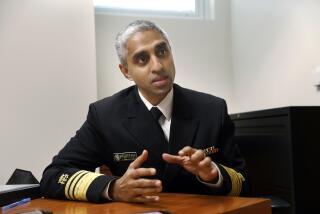Doctor Seeks to Cure Violence by Battling It Like Any Disease : Her approach was once considered bizarre. But her pioneering efforts have helped create a growing medical care specialty.
- Share via
BOSTON — Deborah Prothrow-Stith took the same classic courses at Harvard Medical School as everyone else, but in 1978 she carved out her own specialty: violence as a public health emergency. In 1978, that seemed bizarre. In 1992, especially after the Los Angeles riots, she seems right on the money.
“Our children are killing each other because we teach violence, we promote it,” she says. “As a society, we think it’s justified, painless, guiltless. From the media to the movies to the presidency, the message is the same.
“We now have a kick-butt President preceded by a ‘Make My Day’ one. Kick-butt was how Bush spoke about Geraldine Ferraro and Saddam Hussein. ‘Make My Day!’ is what Reagan said to Kadafi. It suggests enjoying violence.”
Today an assistant dean at Harvard School of Public Health, Prothrow-Stith was Massachusetts’ first female, and youngest ever (age 33) commissioner of public health when she served from 1987-89.
As creator of the “Violence Prevention Curriculum for Adolescents,” now used in 5,000 schools in 48 states and seven countries, she is recognized as a national expert on adolescent violence.
“There’s nothing like this on the market,” says Alice Schaeffer, assistant educational director of Craig House in Pittsburgh, Pa., a school for students with behavior disorders. The course “gives kids a totally different perception of what violence is,” says Schaeffer. “And gives them a way to solve problems.”
The statistics are stunning. The United States has the fifth-highest recorded homicide rate in the world. And homicide is the leading cause of death for young black males age 18-24. Young black males in Harlem have a lower life expectancy than young men in Bangladesh, the poorest country in the world.
The latest numbers came out earlier this month. Reports from the National Center for Health Statistics showed that bullets are killing young black men at a greater rate in Los Angeles County than anywhere else in the United States except the District of Columbia. For all young people, the reports showed, gunfire is the second most common cause of death.
The findings were published in the June 10 edition of the Journal of the American Medical Assn., which had a dozen articles devoted to violence in America.
Black males are over-represented as victims of violence and are more at risk, but Prothrow-Stith is adamant that violence has no racial fence around it. Everyone is at risk in this society “where people are infatuated with violence,” she believes.
The urban violence shocked Prothrow-Stith when she worked in the emergency rooms of Boston City Hospital and Peter Bent Brigham Hospital (now called Brigham and Women’s Hospital).
“It hit me--all we did was stitch them up and send them out, stitch them up and send them out. We did nothing to prevent more violence.
“Now, that wasn’t true of any other disease or injury we treated there. We never sent a heart attack victim home to just have another heart attack. We taught him about diet and exercise and stress. We never sent a suicide attempt home to just try it again. We offered counseling, support--we always did something to prevent them coming right back in again. But victims of violence? We did nothing.”
The ER was simply a revolving door and Prothrow-Stith, who continues to work one night a week as a practicing physician at a clinic for teen-agers, felt the medical Establishment had to do more. For years, she was alone--fighting violence as if it were a disease that robbed American children of their lives and limbs.
Today it is a growing field for health care workers.
“Deborah is the leading public health person in violence prevention today,” says Billie Weiss, an epidemiologist who is director of Injury Prevention Project in Los Angeles. “We all look to her.”
“She’s one of the most powerful and articulate speakers I’ve ever heard,” says Dr. Mark L. Rosenberg, the Center for Disease Control’s first chief of the Epidemiology of Violence and today director of its Injury Control Division. “She’s done all communities a terrific service developing this curriculum. It does give us hope.”
Profile: DEBORAH PROTHROW-STITH
Born: Feb. 6, 1954, in Marshall, Tex.
Hometown: Roxbury, Mass.
Education: Spellman College, Atlanta (mathematics) 1975; Harvard University Medical School, 1979.
Career highlights: January-June, 1982, senior resident in charge of medical/surgical unit, Boston City Hospital; 1987-89, Massachusetts commissioner of public health; July, 1990, to present, assistant dean for government and community programs, Harvard School of Public Health; 1991, author, with Michaele Weissman, of “Deadly Consequences: How Violence is Destroying our Teenage Population and a Plan to Begin Solving the Problem”; author of a violence prevention curriculum for adolescents.
Personal: Married to the Rev. Charles Stith, pastor of Union United Methodist Church, Boston. . . . They live with their two children and a nephew, ages 10-22.






